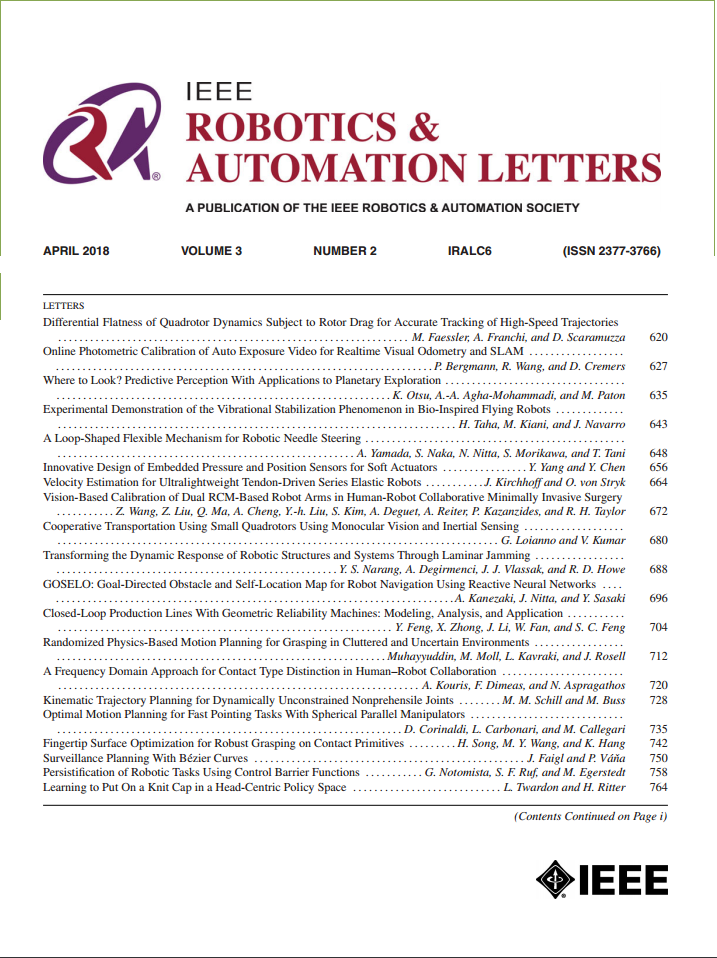Electronics-Free 3D-Printed Soft Swimming Robot With Pneumatic Oscillating Control for Efficient Undulating Locomotion
IF 4.6
2区 计算机科学
Q2 ROBOTICS
引用次数: 0
Abstract
Soft robots, with their compliance and adaptability, are ideal for applications requiring continuously flexible, dynamic movement, making them promising candidates for underwater locomotion. However, current swimming soft robots often rely on electronic power sources and complex, labor-intensive manufacturing, limiting their scalability and use in challenging environments. Recent advancements in 3D printing, particularly fused filament fabrication (FFF), offer a practical alternative for fabricating soft robots, enabling monolithic structures that require minimal assembly. In this work, we introduce a pneumatically powered, electronics-free swimming robot, fully fabricated from soft thermoplastic elastomer (TPE) using a desktop FFF 3D printer. Inspired by the morphology of the tadpole, our design incorporates a pneumatic oscillating controller as the “brain” and segmented actuators as the “tail,” enabling autonomous undulating propulsion without electronics. We demonstrate untethered operation using a portable CO2 canister and characterize two robot configurations optimized for efficient swimming. The robots achieve controlled oscillation and effective underwater movement, reaching a maximum speed of 0.70 body lengths per second (BL/s). This electronics-free, 3D-printed design represents a step forward in creating low-cost, accessible soft robotic platforms, suited for exploration in aquatic environments where electronics are impractical.无电子3d打印柔性游泳机器人与气动振荡控制高效波动运动
软机器人具有顺应性和适应性,是需要持续灵活动态运动的应用的理想选择,使其成为水下运动的有希望的候选者。然而,目前的游泳软体机器人通常依赖于电子电源和复杂的劳动密集型制造,限制了它们的可扩展性和在具有挑战性的环境中的使用。3D打印的最新进展,特别是熔丝制造(FFF),为制造软机器人提供了一种实用的替代方案,实现了需要最少组装的单片结构。在这项工作中,我们介绍了一种气动,无电子游泳机器人,完全由软热塑性弹性体(TPE)制成,使用桌面FFF 3D打印机。受蝌蚪形态的启发,我们的设计结合了一个气动振荡控制器作为“大脑”,分段执行器作为“尾巴”,实现了无需电子设备的自主波动推进。我们演示了使用便携式CO2罐的无系绳操作,并描述了两种优化的高效游泳机器人配置。机器人实现可控振荡和有效的水下运动,达到每秒0.70身长(BL/s)的最大速度。这种无电子设备的3d打印设计代表了在创造低成本,可访问的软机器人平台方面迈出的一步,适合在电子设备不切实际的水生环境中进行探索。
本文章由计算机程序翻译,如有差异,请以英文原文为准。
求助全文
约1分钟内获得全文
求助全文
来源期刊

IEEE Robotics and Automation Letters
Computer Science-Computer Science Applications
CiteScore
9.60
自引率
15.40%
发文量
1428
期刊介绍:
The scope of this journal is to publish peer-reviewed articles that provide a timely and concise account of innovative research ideas and application results, reporting significant theoretical findings and application case studies in areas of robotics and automation.
 求助内容:
求助内容: 应助结果提醒方式:
应助结果提醒方式:


